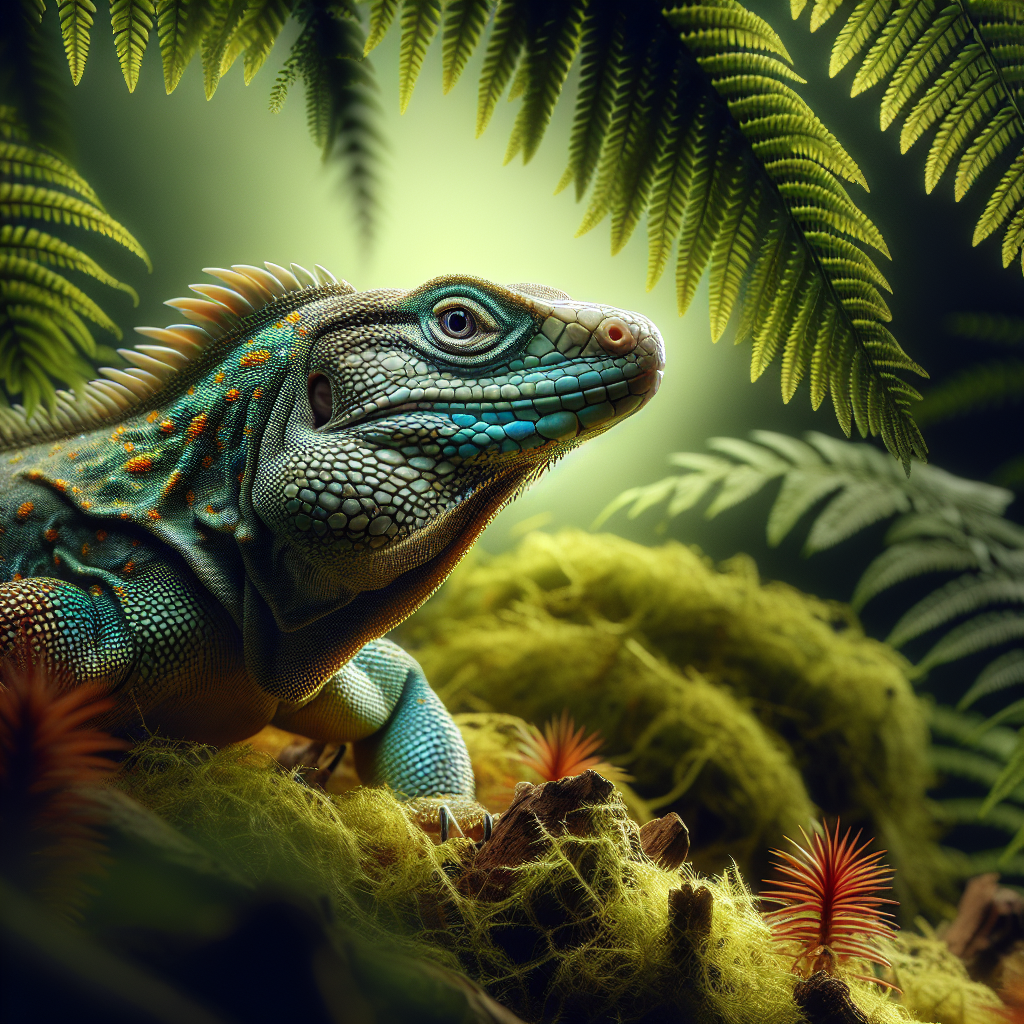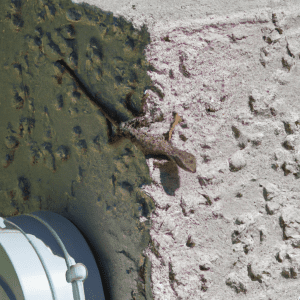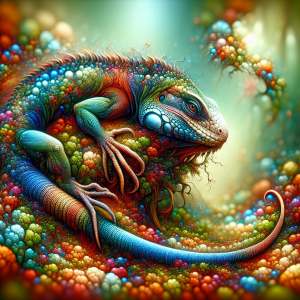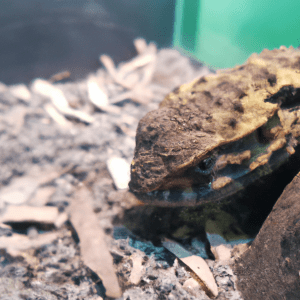Introduction: Importance of Habitat Maintenance for Healthy Lizards
Imagine you’ve just brought home a charming little lizard buddy and you’re excited to create the perfect habitat for them. That’s where the magic of habitat maintenance for healthy lizards comes in! I must say, it’s like being an interior designer but for your scaly friend.
Let me share a personal anecdote with you – when I first set up a habitat for my pet lizard, I thought a couple of rocks and a heat lamp would do the trick. But boy, was I wrong! It wasn’t until I delved deeper into the world of lizard care that I realized the intricacies of maintaining a healthy habitat.
Understanding the unique requirements of your lizard species is key. Did you know that different types of lizards have specific habitat needs? It’s fascinating how factors like temperature, humidity, and lighting play crucial roles in replicating their natural environment. Think of it as creating a mini-ecosystem within your home!
As you embark on this habitat maintenance journey, consider the challenge of striking the perfect balance. How do you ensure your lizard’s habitat is not just functional but also aesthetically pleasing? It’s like decorating a tiny reptilian paradise!
Now, here’s a practical tip for you: research is your best friend. Dive into resources, consult experts, and don’t hesitate to ask questions. The more you know about your lizard’s habitat requirements, the better equipped you’ll be to provide a safe and comfortable space for them.
So, are you ready to take on the role of a habitat curator for your scaly companion? The significance of maintaining a healthy habitat goes beyond just aesthetics; it directly impacts your lizard’s health and well-being. Let’s roll up our sleeves and create a lizard oasis that your pet will truly appreciate!
Understanding Lizard Habitat Requirements
Understanding lizard habitat requirements is crucial when it comes to providing a healthy and thriving environment for our scaly friends. Just like we need a comfortable and safe place to live, our pet lizards also have specific needs that must be met to ensure their well-being.
When I first started learning about lizard care, I was surprised to discover how intricate their habitat requirements can be. It’s not just about throwing some substrate and a heat lamp into a tank and calling it a day. Lizards have evolved to thrive in specific environments, and it’s our responsibility as their caretakers to mimic those conditions as closely as possible.
One interesting fact about lizard habitats is that different species have varying requirements based on their natural habitats. For example, desert-dwelling lizards like bearded dragons need a hot and dry environment with plenty of basking spots, while tropical species such as anoles require higher humidity levels and access to UVB lighting for proper calcium absorption.
To meet these diverse needs, we must delve into the specifics of temperature, lighting, humidity, substrate, and enclosure size. It’s like creating a mini ecosystem within their tank, where every element plays a crucial role in their overall health and happiness.
As we continue our conversation about lizard habitat requirements, think about how these factors interact with each other to create a balanced environment for our scaly companions. By understanding and addressing their habitat needs, we can ensure that our lizards lead healthy and fulfilling lives in captivity.
Creating the Ideal Habitat Setup
When it comes to creating the ideal habitat setup for your pet lizard, there are a few key things to keep in mind. Imagine you’re an interior designer, but instead of decorating for humans, you’re sprucing up a cozy abode for your scaly friend. It’s all about creating a space that mimics their natural environment, making them feel right at home.
First off, think about the size of the enclosure. Just like how we wouldn’t want to live in a cramped space, lizards need room to roam and explore. It’s like giving them their own little lizard kingdom to rule over! Consider the size and layout of the enclosure to ensure your lizard has plenty of space to move around comfortably.
Next up, let’s talk about the importance of providing hiding spots and climbing opportunities. Lizards are curious creatures by nature, and they love to explore different nooks and crannies. Think of it like setting up a fun obstacle course for your lizard to navigate through – complete with cozy hideouts for when they need a break.
Now, onto the decor details – substrate selection. This is where you get to choose the flooring for your lizard’s living space. Some lizards prefer sandy substrates, while others may enjoy a more lush and green environment. It’s like picking out the perfect rug for your living room – you want something that looks good and feels comfortable underfoot.
And don’t forget about the finishing touches – temperature and lighting considerations. Just like how we adjust the thermostat to stay cozy, lizards rely on specific temperature gradients and lighting setups to stay healthy and happy. It’s like creating a mini tropical paradise right in your own home!
By paying attention to these key elements and channeling your inner interior designer, you can create a habitat that not only meets your lizard’s needs but also provides them with a comfortable and stimulating environment to thrive in. It’s all about creating a space that your scaly companion will love to call home.
Temperature and Lighting Considerations
When it comes to maintaining a healthy habitat for your lizards, one crucial aspect that often gets overlooked is temperature and lighting considerations. Let me share some insights on why this is so important.
Imagine this – a few years ago, when I first brought home my pet lizard, I didn’t realize how sensitive they are to temperature fluctuations. One day, I noticed that my lizard was sluggish and not as active as usual. After some research, I discovered that the temperature in its habitat was too low, causing it stress and affecting its overall health. That’s when I realized the significance of getting the temperature and lighting just right for our scaly friends.
Now, here’s an interesting fact for you: Did you know that lizards are ectothermic animals, which means they rely on external heat sources to regulate their body temperature? This makes it crucial for us as pet owners to provide them with the right temperature gradients within their habitat to ensure they can thermoregulate effectively.
To ensure your lizard’s well-being, it’s essential to set up a thermal gradient in their enclosure. This means creating a range of temperatures throughout the habitat, including basking spots that reach optimal temperatures for digestion and overall health. Additionally, providing a full-spectrum UVB light source is vital for lizards to synthesize vitamin D3, which is essential for calcium metabolism and preventing diseases like metabolic bone disease.
By paying attention to these temperature and lighting considerations, you can create a comfortable and healthy environment for your lizards to thrive. Remember, mimicking their natural habitat as closely as possible is key to their overall well-being.
So, next time you’re setting up your lizard’s habitat, think about how you can create the perfect balance of warmth and light to keep your scaly companions happy and healthy.
Humidity and Moisture Control
Let me tell you all about humidity and moisture control when it comes to maintaining a healthy habitat for your lizards. It’s a crucial aspect that can greatly impact your reptile friends’ well-being.
Now, imagine this: You’ve set up the perfect habitat for your lizard, complete with all the necessary elements like heat lamps and hiding spots. Everything seems great, but you start noticing that your lizard’s skin is looking a bit dry, and it’s not shedding properly. What could be the issue? That’s where humidity and moisture control come into play.
Did you know that different species of lizards have varying requirements when it comes to humidity levels in their habitat? Some lizards, like bearded dragons, need a relatively low humidity level, while others, such as chameleons, require higher humidity to thrive. Understanding your specific lizard’s needs is key to maintaining optimal humidity levels.
Maintaining the right humidity level is essential for your lizard’s respiratory health, hydration, and overall comfort. Too much humidity can lead to mold growth, bacterial infections, and skin issues for your lizard. On the other hand, too little humidity can cause dehydration and shedding problems.
So, how can you ensure proper humidity and moisture control in your lizard’s habitat? One practical tip is to invest in a hygrometer to monitor the humidity levels regularly. You can adjust the humidity by misting the enclosure with a spray bottle or using a reptile fogger to create a more humid environment when needed.
Remember, providing a water source in the enclosure and incorporating live plants can also help maintain adequate humidity levels naturally. By finding the right balance and making adjustments as needed, you can create a comfortable and healthy habitat for your beloved lizards.
Think about this: How do changes in humidity levels in the wild affect lizards’ behavior and survival? Understanding the role of humidity in lizard habitats can deepen your appreciation for these fascinating creatures and enhance your care practices.
Substrate Selection and Maintenance
Substrate selection and maintenance might not sound like the most exciting part of creating a lizard habitat, but trust me, it’s crucial for your scaly friend’s well-being. Let me share some insights on this topic.
Choosing the right substrate is like picking the perfect bedding for your own bed – it needs to be comfy and functional. Remember the time I tried to use sand as a substrate for my lizard’s enclosure? It turned into a messy disaster real quick! That’s when I learned the importance of selecting safe and suitable substrates that mimic your lizard’s natural environment.
Did you know that some substrates can impact your lizard’s health? For example, certain loose substrates like sand or gravel can pose a risk of impaction if ingested. Opt for safer options like reptile carpet, paper towels, or coconut fiber to minimize this risk and make cleaning a breeze.
Maintaining the substrate is just as important as choosing the right one. Regular spot cleaning and complete substrate changes are necessary to prevent bacterial growth and maintain a hygienic environment for your lizard. Remember, a clean habitat is a happy habitat!
Now, here’s a practical tip for you: consider your lizard’s species and behavior when selecting a substrate. Some lizards prefer burrowing, so a loose substrate like coconut fiber might be ideal. Others might do better with a solid substrate for easy movement.
Think about it this way: would you want to walk on uncomfortable flooring all day? Probably not! Providing a suitable substrate ensures your lizard can move around comfortably and exhibit natural behaviors, contributing to their overall health and happiness.
So, the next time you’re setting up your lizard’s habitat, pay special attention to the substrate. It may not be the flashiest part of the enclosure, but it plays a vital role in creating a safe and comfortable home for your scaly companion.
Providing Proper Food and Water Sources
When it comes to providing proper food and water sources for your pet lizard, there are a few key things to keep in mind. I remember when I first got my bearded dragon, I thought all I needed to do was throw some crickets in its tank and call it a day. Little did I know, there’s a bit more to it than that.
One interesting fact about feeding lizards is that their dietary needs can vary depending on the species. Some lizards are strictly herbivores, while others are carnivores or omnivores. Researching your specific lizard’s dietary requirements is crucial to ensure they are getting the nutrients they need to thrive.
Now, onto the practical advice. When it comes to feeding your lizard, variety is key. Just like us, lizards enjoy a diverse diet. This can include live insects like crickets, mealworms, and dubia roaches, as well as fresh fruits and vegetables. Remember to dust your feeder insects with a calcium supplement before offering them to your lizard to prevent any nutritional deficiencies.
Another important aspect to consider is hydration. Providing a shallow dish of clean, fresh water in your lizard’s enclosure is essential for their well-being. Some lizards may not drink directly from a dish, so you can also mist their enclosure to increase humidity and allow them to drink water droplets.
Ensuring your lizard has access to the right food and water is not just about their physical health—it also contributes to their mental well-being. Imagine being fed the same meal every day, it would get pretty boring, right? Offering a variety of foods and ensuring they have access to water can keep your lizard happy and engaged.
So, next time you’re feeding your scaly friend, remember to mix it up and keep their taste buds (or should I say taste buds?) excited!
Enrichment and Behavioral Stimulation
You know, providing enrichment and stimulation for your lizard can be a lot of fun! It’s like planning a little adventure park for your scaly friend right in their habitat. You’d be surprised at how much joy and activity you can bring to their lives with just a few simple additions.
Think about it this way: lizards are naturally curious creatures, just like us. They love exploring, climbing, and hunting for their food. By adding elements like branches for climbing, hiding spots for privacy, and even some puzzle feeders for mental stimulation, you’re essentially turning their enclosure into a lizard paradise. It’s a win-win situation – your lizard gets to stay active and engaged, and you get to witness their natural behaviors up close.
I remember when I first introduced some new climbing structures and tunnels to my lizard’s habitat. It was like watching a mini Jurassic Park unfold right in my living room! Seeing my lizard navigate through the obstacles with such agility and excitement was truly a sight to behold. It made me realize just how important it is to cater to their natural instincts and provide them with a dynamic environment to thrive in.
So, the next time you’re thinking about sprucing up your lizard’s habitat, consider adding some interactive elements to keep them entertained and engaged. Not only will it benefit their physical and mental well-being, but it’ll also make for some entertaining moments for you as you observe your little reptilian friend explore their enriched environment. After all, who said pet care couldn’t be a little adventurous and fun?
Monitoring Health and Wellness Indicators
Have you ever noticed how our pets often communicate their well-being through subtle signs? The same goes for lizards! When it comes to monitoring the health and wellness of your scaly friend, it’s essential to pay attention to their behavior and physical cues.
For instance, have you ever seen your lizard basking under the heat lamp for longer periods than usual? This behavior could indicate that they are trying to regulate their body temperature. Lizards are ectothermic creatures, meaning they rely on external heat sources to maintain their body temperature. By observing their basking habits, you can gauge if the temperature gradient in their habitat is appropriate for them.
Another vital aspect to consider is their eating habits. Lizards, like humans, have individual preferences when it comes to food. If you notice a sudden decrease in appetite or weight loss, it could be a red flag for underlying health issues. Regularly monitoring their food intake and weight can help you detect any health concerns early on.
Moreover, keep an eye out for any changes in their skin condition. Shedding is a natural process for lizards, but complications such as retained shed or skin lesions can indicate health problems. Ensuring proper humidity levels in their habitat can aid in successful shedding and promote healthy skin.
By observing these indicators and taking proactive measures, you can help maintain your lizard’s overall well-being. Remember, a healthy lizard is a happy lizard! So, next time you interact with your scaly companion, pay attention to these subtle cues to ensure they lead a vibrant and content life. After all, our pets rely on us to provide them with the best care possible.
Ensuring Long-Term Health and Happiness for Your Lizard
Have you ever considered the importance of monitoring health and wellness indicators for your pet lizard? It’s not just about observing their behavior; there are specific signs to look out for that can indicate their overall well-being. For instance, subtle changes in appetite, activity levels, skin condition, and even weight can provide valuable insights into your lizard’s health.
One time, I noticed that my leopard gecko, Luna, was becoming less active and seemed to be eating less than usual. At first, I thought she might be stressed or adjusting to her new environment, but after observing her closely, I realized there might be an underlying health issue. It turned out that she was experiencing some digestive issues, and prompt veterinary care helped address the issue before it became more serious. This experience taught me the importance of regularly monitoring my lizard’s health indicators to catch any potential problems early on.
When it comes to your own lizard, it’s essential to establish a baseline for what is normal behavior and appearance. By paying close attention to their habits and physical condition, you can quickly spot any deviations that may indicate a health concern. Regularly weighing your lizard, keeping track of their shedding patterns, and monitoring their food intake can all help you stay proactive in maintaining their well-being.
So, the next time you interact with your lizard, take a moment to observe and assess their health indicators. Remember, early detection of any health issues can make a significant difference in your pet’s overall quality of life. By staying vigilant and proactive, you can ensure that your lizard remains healthy and happy for years to come.




